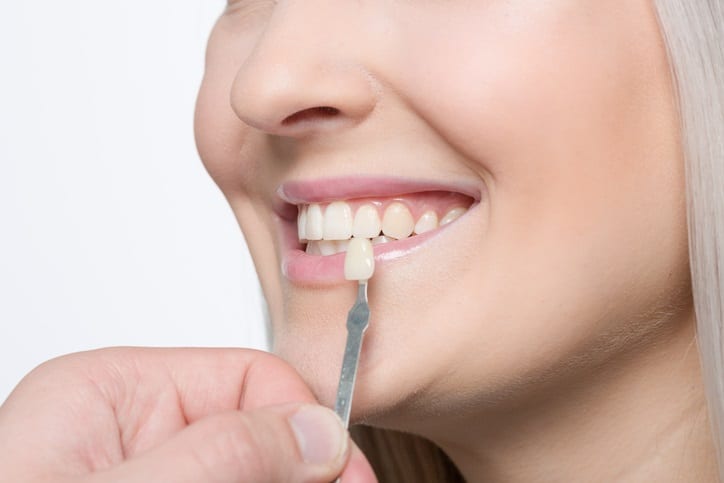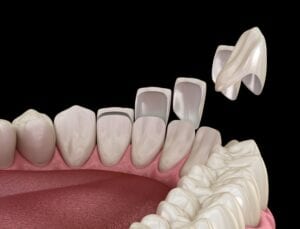Lighting up a room doesn’t have to mean turning on a lamp. People all across Texas are gaining radiant smiles without painful and intrusive braces or temporary bonding. If you’re tired of hiding your smile, veneers may be the right solution for you.
Veneers are made of thin porcelain shells that are custom made to fit over teeth, providing a natural, attractive look. They are used to recreate the look of teeth while also providing strength and resilience equivalent to natural tooth enamel. Veneers can also be useful in treating chipped, stained, misaligned, worn down, uneven or abnormally spaced teeth.
Your veneers are custom made to fit the exact shape of your teeth and are bonded to the tooth’s original enamel through a series of painless in-office visits. If you have teeth that are severely discolored, chipped, small or misshapen, veneers can create a long-lasting and bright smile. Plus, frequent coffee or tea drinkers can rejoice, as quality veneers are very difficult to stain!

Who Benefits from Veneers?
There is no specific type of person or age, just about everyone appreciates a beautiful smile. Popular with Hollywood actors on the big screen to social media influencers, real estate agents and business owners. Getting veneers often makes patients feel more confident and dramatically improves smiles.
Upper veneers are the most popular option, creating a uniform and consistent smile. Veneers can also be done on a single tooth and even a full veneer crown is a procedure our practice performs.
The Veneering Procedure
Veneering usually requires at least two visits. The first visit may take up to two hours. During this visit:
- Your dentist carefully examines your teeth and determines the correct color shade for the veneer. The dentist then removes a very small amount of tooth enamel (typically 0.5 – 0.7 mm) to provide room to place the veneer on the tooth.
- The dentist then takes an impression to create an exact replica of your teeth. This impression is used to make a model for your custom made porcelain veneer.
- Temporary veneers may or may not be placed depending on the amount of tooth structure removed and type of changes made during the visit.

The second visit is when the transformation happens and may also take between one to two hours. During this visit:
- The dentist removes any temporary veneers.
- The porcelain veneer fit is evaluated by a dentist and then by you. This is a time for you to check the shape and color, fit and feel of the veneers to see if they meet your expectations before, they are bonded to your teeth. The dentist can usually make any changes you want before they are bonded to your teeth. Once porcelain veneers are bonded it is best not to adjust them.
- Once you approve of your veneers your teeth will be thoroughly cleaned with pumice and water or a mild acidic solution. A tooth-colored bonding adhesive is applied to the teeth and veneer, then dried and light cured to your teeth to create a strong bond.
- Lastly, any excess material is removed and your veneers are polished.
- Now you’re ready to show off your new smile!
Advantages and Limitations of Veneers
Veneers offer a more conservative solution to improving the look and feel or your teeth than other dental procedures such as crowns. They look and feel natural and are highly stain resistant. Gum tissue also typically tolerates porcelain very well. During the procedure, you and your dentist can select the color shade for your veneers so you can make dark or very stained teeth appear bright white and shiny.
Veneers can act as “immediate orthodontics” because they can usually correct or hide a variety of dental problems from gaps between teeth to severely stained or chipped teeth. It’s important to understand dental veneers can’t realign your jaw or correct overbites and underbites or make room for full sized teeth. These problems usually require orthodontics such as Invisalign before applying veneers.
It’s important to know dental veneers are not the best choice for every tooth and only a knowledgeable and experienced dentist can determine if appropriate for you. Veneering teeth is typically non-reversible, so you will want to make sure it’s a good fit first. Some typical situations that might require treatment before getting veneers include: unhealthy teeth and gums, weakened teeth, teeth with inadequate enamel, people who clench or grind their teeth, and anyone with misaligned teeth or an unstable bite. Many of these situations do not rule out veneers completely, but often require treating disease, decay or misalignment before your veneers are placed.
Bonding Vs. Veneers
When it comes to choosing a solution, which should you pick? If the issues with your teeth are minor and don’t need extensive treatment, dental bonding is a terrific choice. Dental bonding utilizes a tooth-colored resin bonded to the surface of the tooth. The material is highly durable and specially made to match the color of your existing teeth. Bonding can improve the appearance of the teeth with little or no drilling or anesthesia. Bonding is typically done as a one appointment procedure so it’s often considered a “faster” procedure than a porcelain veneer, which takes at least two appointments.
Keep in mind bonding is used primarily as a way to improve the appearance of the front teeth or “smile zone.” Bonded teeth are not strong enough to withstand the pressure exerted on the back teeth or any of the chewing surfaces of the teeth, especially if you’re a habitual ice cruncher. Composite resin materials also have a tendency to stain rather easily, especially if you smoke, drink coffee or tea, or eat certain types of foods. Veneers, on the other hand, are a highly stain-resistant solution and strong enough to be applied to all teeth.
The biggest challenge with bonding is the limitations of the material. It’s often harder to cover very dark or discolored teeth. The ability to get an excellent result really depends on your dentist’s artistic skills and ability to manipulate the materials inside your mouth in a way that attempts to match the quality of porcelain veneer. A single tooth or a few teeth are relatively straightforward, but an entire smile can be challenging to get consistent results.
Veneers, on the other hand, are created from a detailed mold and fit your teeth precisely. Veneers can create a beautiful, white, and even smile almost immediately and can typically cover cracks, stains, and poorly shaped teeth much more effectively than bonding. Veneers also allow for minimal removal of tooth structure and can be made to the ideal shape, size, and color.
The downside to veneers is they often come with a higher price tag due to being custom made and taking an additional appointment to place. Our practice favors veneers more often than bonding because, at the end of the day, we can simply get better looking results with veneers. Ultimately, however, it’s best to speak with your dentist about the specific advantages and disadvantages of each solution so you can make the decision that’s right for you.
In Summary…
If your smile just isn’t making you smile, it may be time to come in for an appointment. One of our experienced dentists will be able to recommend a particular treatment after a thorough examination of your teeth and consideration of your individual needs. Sometimes if the problem is simply due to discoloration, teeth whitening treatments can yield perfectly acceptable results and veneers are not required. In cases of tooth decay or misalignment, other treatments may be recommended before veneer placement. No matter what, there’s no reason you need to live with an unhealthy smile. Call or schedule an appointment online today!

